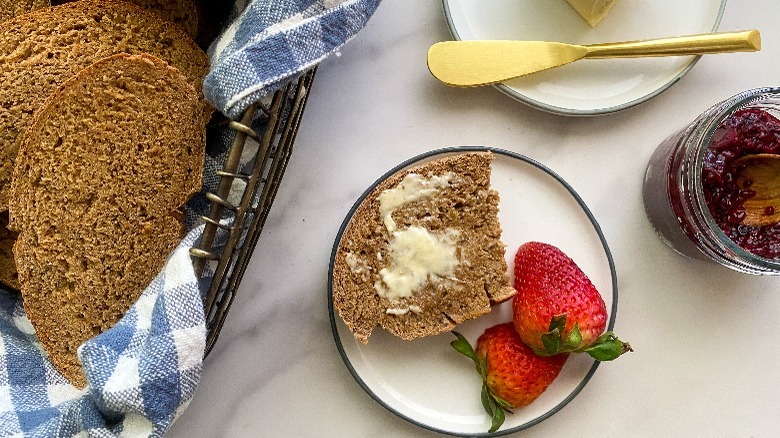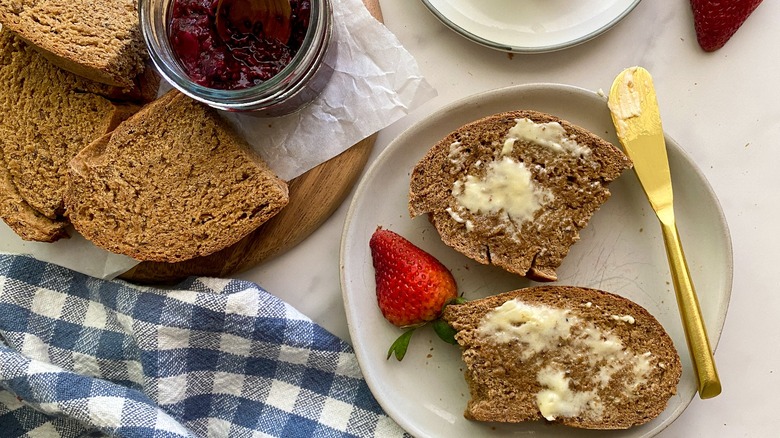Easy Pumpernickel Bread Recipe
We may receive a commission on purchases made from links.
Every culture enjoys bread as a staple in their diet, and there are hundreds of variations in bread recipes from around the world. Pumpernickel bread is a classic German bread known for its dark color and rich flavor with a hint of sweetness. It's denser than most breads and is perfect for those that love a rustic and hearty loaf.
If you want to know how to make pumpernickel bread, recipe developer Miriam Hahn brings us this easy recipe and says, "Making your own pumpernickel bread may seem intimidating, but it's really quite simple — you don't even need to get the stand mixer out. My favorite ingredient in this recipe is the molasses. It's sweet but leans more towards a smoky, caramel taste. That, combined with the cocoa powder, makes this bread very versatile. You can serve it for breakfast or dinner." Pumpernickel bread makes a great sandwich with deli meats and sauerkraut or a nice complement to your breakfast with butter and jam.
Gather the ingredients for easy pumpernickel bread
To make this recipe, you'll need to pick up some bread flour and rye flour. This combination will provide the dark, dense bread that Pumpernickel is known for. Then, you'll need some salt, instant yeast, caraway seeds, cocoa powder, molasses, warm water, and olive oil. "Using instant yeast saves us some time, as we don't have to wait for it to activate with the water separately," Hahn remarks.
Make the pumpernickel bread dough
Our first step is to get our dough going. In a large bowl, combine the rye flour, bread flour, salt, yeast, caraway seeds, and cocoa powder. Add the molasses and the water, and stir to combine. Once it gets too hard to stir, remove it from the bowl and place it on a floured surface. Knead the dough for about 10 minutes, until it is nice and smooth. "This dough is very dense and will be more of a workout to knead than white bread, but it will be worth it. Just keep adding flour to the dough and to your work surface to help with the stickiness. After about 10 minutes, it should be smooth and no longer sticky," Hahn explains.
Let the pumpernickel bread dough rest and rise
Now, coat a large bowl with the oil and place the ball of dough inside. Cover with plastic wrap and let it sit for 2 hours. "Try and find a warm location to let the dough rest ... As time goes on, it will double in size," Hahn says. About 15 minutes before the rest time has passed, preheat the oven to 425 F and place a baking dish full of water on the bottom rack to heat up. This will help create steam while the bread is cooking and give us a crispy crust.
Bake, cool, and serve the pumpernickel bread
Uncover the bowl that the dough has been resting in and place the dough on a cutting board. Form it into an oval shape and transfer it onto a baking sheet. Pop it into the preheated oven and bake for 40 minutes. Remove it from the oven and let it cool for about 30 minutes before slicing. Your kitchen should be smelling amazing by now. The bread will last for several days if kept in an air-tight container on the counter or the fridge. Yummy sandwiches, here we come!
Ideas for serving your pumpernickel bread
Easy Pumpernickel Bread Recipe
Add pumpernickel bread to your baking repertoire with this classic recipe that flavors the bread with caraway seeds, molasses, and cocoa powder.

Ingredients
- 2 cups rye flour
- 1 ⅔ cup bread flour
- 1 teaspoon salt
- 4 ½ teaspoons instant yeast
- 3 tablespoons caraway seeds
- 1 tablespoon cocoa powder
- ¼ cup molasses
- 1 ½ cups warm water
- 2 teaspoons olive oil
Directions
- In a large bowl combine the rye flour, bread flour, salt, yeast, caraway seeds, and cocoa powder. Now add the molasses and the water. Stir to combine.
- Place the dough on a floured surface and knead it for 10 minutes. Keep adding flour as needed to help with the stickiness. After 10 minutes it should be smooth. Form it into a ball and place it into a bowl that has been coated with olive oil. Cover the bowl tightly with saran wrap and let it rest for 2 hours. It should double in size. About 15 minutes before the rest time has passed, preheat the oven to 425 F and place a baking dish full of water on the bottom rack to heat up.
- Form the loaf into an oval shape and place it on a baking sheet. Put it into the oven to bake for 40 minutes. Let it cool for 30 minutes before slicing.
Nutrition
| Calories per Serving | 250 |
| Total Fat | 2.6 g |
| Saturated Fat | 0.4 g |
| Trans Fat | 0.0 g |
| Cholesterol | 0.0 mg |
| Total Carbohydrates | 50.4 g |
| Dietary Fiber | 5.5 g |
| Total Sugars | 8.3 g |
| Sodium | 268.8 mg |
| Protein | 7.7 g |
What is the history of pumpernickel bread?
In its earliest forms, pumpernickel was made from coarsely ground rye berries, which gave it a tough, dense texture — rye bread is made from a hulled and germed rye berry and doesn't possess the same qualities. The word pumpernickel translates to "devil farts" in German and graced the bread because of the strenuous digestive effects brought on by the original recipe.
Contemporary American pumpernickel recipes (like ours) differ from their German ancestors and cousins in a variety of fashions. As you can tell, we opt for pure rye flour; a traditional recipe would reach for true pumpernickel flour or coarse rye meal. German pumpernickel also often includes sourdough starter and is baked extremely low (at around 300 F) and slow. While we're forgoing true tradition in this easy pumpernickel recipe, the addition of cocoa and molasses to the otherwise standard rye dough helps give the bread a rich, pumpernickel flavor without wreaking intestinal havoc or necessitating a lengthy bake — win, win, win!





